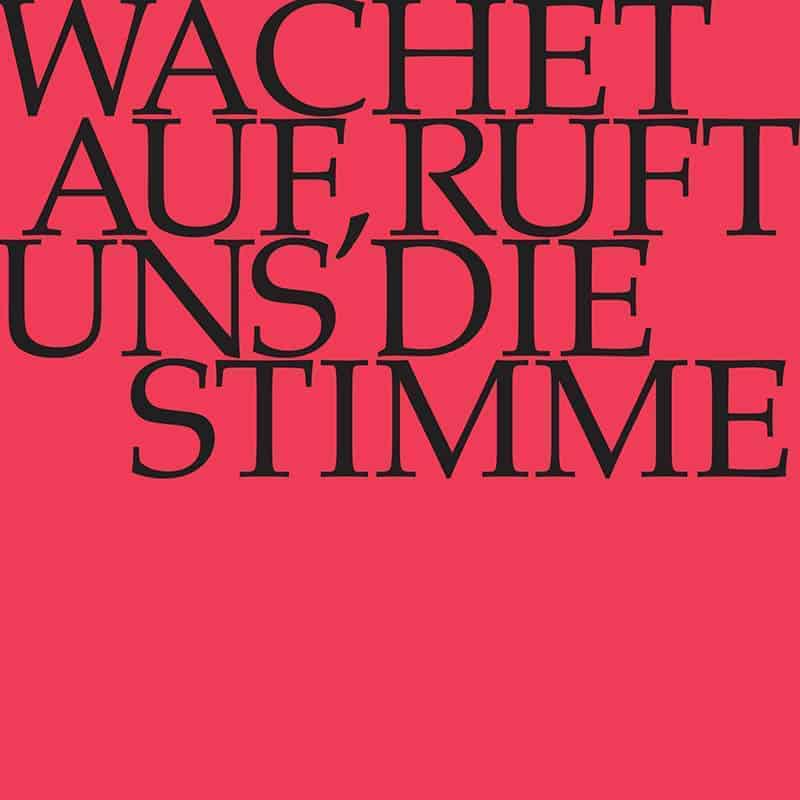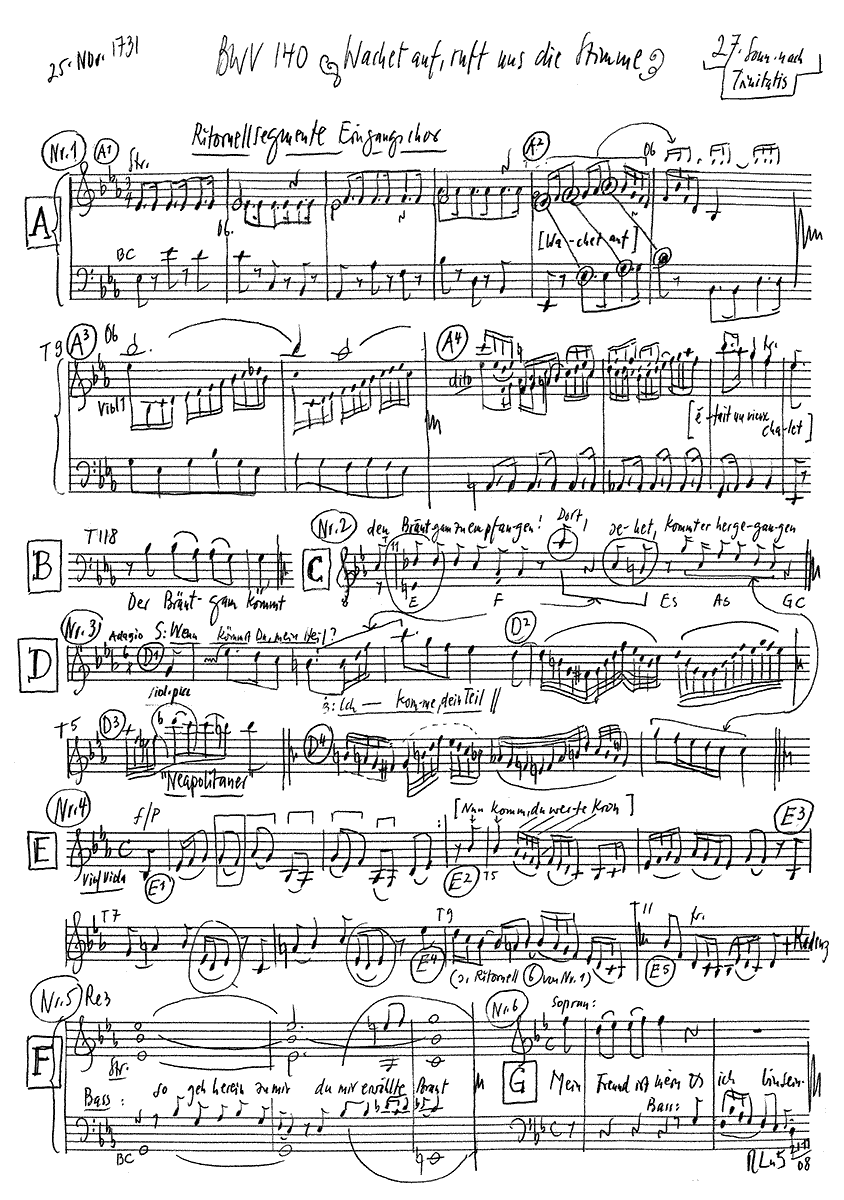Wachet auf, ruft uns die Stimme
BWV 140 // For the Twenty-seventh Sunday after Trinity
(Wake, arise, the voice calls us) for soprano, tenor and bass, vocal ensemble, horn, oboe I+II, taille, bassoon, strings and continuo.
Through their interpretations of the ancient bible stories and parables, baroque church cantatas – almost as a second sermon – strove to provide guidance and instruction that was relevant to the daily lives of the congregations of the time. This was achieved in part by using well-known chorale melodies, but also new librettos for recitatives and arias that were inspired by biblical ideas. Indeed, in Bach’s time the entire Holy Scriptures were considered one entity, and the individual books and passages served to complement and illuminate each other.

Would you like to enjoy our videos ad-free? Subscribe to YouTube Premium now...
Workshop
Reflective lecture
Bonus material
Choir
Soprano
Susanne Frei, Leonie Gloor, Madeline Trösch, Jennifer Rudin
Alto
Jan Börner, Antonia Frey, Olivia Heiniger, Lea Scherer
Tenor
Marcel Fässler, Nicolas Savoy, Walter Siegel
Bass
Fabrice Hayoz, Philippe Rayot, William Wood
Orchestra
Conductor
Rudolf Lutz
Violin
Renate Steinmann, Sylvia Gmür, Sabine Hochstrasser, Martin Korrodi, Olivia Schenkel
Violino piccolo
Chiara Banchini (special Guest)
Viola
Susanna Hefti, Martina Bischof
Violoncello
Maya Amrein
Violone
Iris Finkbeiner
Oboe
Martin Stadler, Luise Baumgartl
Oboe da caccia
Esther Fluor
Taille
Esther Fluor
Bassoon
Susann Landert
Horn
Ella Vala Armannsdottir
Organ
Norbert Zeilberger
Musical director & conductor
Rudolf Lutz
Workshop
Participants
Karl Graf, Rudolf Lutz
Reflective lecture
Speaker
Beatrice Von Matt
Recording & editing
Recording date
11/21/2008
Recording location
Trogen
Sound engineer
Stefan Ritzenthaler
Director
Meinrad Keel
Production manager
Johannes Widmer
Production
GALLUS MEDIA AG, Switzerland
Producer
J.S. Bach Foundation of St. Gallen, Switzerland
Librettist
Text No. 1, 4, 7
Philipp Nicolai, 1599
Text No. 2, 3, 5, 6
Poet unknown
First performance
Twenty-seventh Sunday after Trinity,
25 November 1731
In-depth analysis
Cantata BWV 140 is a perfect example of this type of compositional approach. Three verses of Philipp Nicolai’s hymn of 1599 “Wachet auf, ruft uns die Stimme” (Wake, arise, the voices call us) function as the underpinnings of the entire work by marking the vibrant E flat major introductory, middle and closing movements respectively. Of particular effect is the monumental introductory chorus, richly scored with four vocal parts, three oboes, strings, horn and continuo. Its chorale melody is sustained in long tones by the soprano voice over a hive of activity in the remaining parts. This creates an effect often described as a musical “awakening”, but that is equally characteristic of a processional (“go forth to meet him as he comes!”). In the same vein, it is possible to interpret the juxtaposed oboe and string parts as representing the ten wise and foolish virgins, or alternatively, as the midnight call and answer recalled in the text. A moment of rapture then emerges in the virtuosic setting of the hallelujah lines – a mood that likewise pervades the cantata’s solo movements.
The tenor recitative “He comes, he comes, the bridegroom comes!” brings the work from biblical times into the present and the world of Christian bridal theology inspired by the Song of Solomon. Bach musically interprets this book of the Bible as a dialogue between Jesus (bass) and the faithful soul (soprano). Nonetheless, their two aria duets (movements 3 and 6) could hardly be more at variance. In a dark C minor, the first aria (“When com’st thou, my Saviour? I’m coming, thy share”) is shaped by questioning pauses and a fragile cantilena from the violino piccolo (which sounds a third higher than a violin) to create a nocturnal adagio serenade pregnant with doubt and uncertainty. In contrast, the second aria, “My friend is mine/And I am thine” – in a bright B flat major and with an obbligato oboe accompaniment – revels in sumptuous consonances and recounts an all-enduring love with infectious joy. It is precluded by a bass recitative (“So come within to me”) that presents the promise of the Highest not as a worn, dogmatic statement, but as a tender avowal of love. As such, the accompanying strings do not impart the glory of the Passion, but rather the glow of enchantment in the eyes of the beloved.
In the chorale trio no. 4, the tenor embodies the veritable “watchman”, who – supported by the lower unison strings – employs the hymn’s simple triadic motive to express the daughter of Zion’s joy about her bridegroom. It is a festive movement that enjoys enduring popularity, particularly in its arrangement for organ (BWV 645) published by Johann Georg Schübler around 1748.
The closing chorale no. 7, “Gloria to thee be sung now”, numbers among those sublime Bach chorale settings which are so genuinely inspiring it seems unthinkable that the congregation could have resisted joining in the singing.
Libretto
Seele (Sopran)
Jesus (Bass)
1. Choral
Wachet auf, ruft uns die Stimme
der Wächter sehr hoch auf der Zinne,
wach auf, du Stadt Jerusalem!
Mitternacht heisst diese Stunde;
sie rufen uns mit hellem Munde:
wo seid ihr klugen Jungfrauen?
Wohl auf, der Bräutgam kömmt;
steht auf, die Lampen nehmt!
Alleluja!
Macht euch bereit
zu der Hochzeit,
ihr müsset ihm entgegen gehn!
2. Rezitativ (Tenor)
Er kommt, er kommt,
der Bräutgam kommt!
Ihr Töchter Zions, kommt heraus,
sein Ausgang eilet aus der Höhe
in euer Mutter Haus.
Der Bräutgam kommt, der einem Rehe
und jungen Hirsche gleich
auf denen Hügeln springt
und euch das Mahl der Hochzeit bringt.
Wacht auf, ermuntert euch!
den Bräutgam zu empfangen!
Dort, sehet, kommt er hergegangen.
3. Arie (Duett Sopran, Bass)
Seele:
Wenn kömmst du, mein Heil?
Jesus:
Ich komme, dein Teil.
Seele:
Ich warte mit brennendem Öle.
Seele:
Eröffne, den Saal zum himmlischen Mahl.
Jesus:
Ich öffne den Saal zum himmlischen Mahl.
Seele:
Komm, Jesu!
Jesus:
Komm, liebliche Seele!
4. Choral (Tenor)
Zion hört die Wächter singen,
das Herz tut ihr vor Freuden springen,
sie wachet und steht eilend auf.
Ihr Freund kommt vom Himmel prächtig,
von Gnaden stark, von Wahrheit mächtig,
ihr Licht wird hell, ihr Stern geht auf.
Nun komm, du werte Kron,
Herr Jesu, Gottes Sohn!
Hosianna!
Wir folgen all
zum Freudensaal
und halten mit das Abendmahl.
5. Rezitativ (Bass)
So geh herein zu mir,
du mir erwählte Braut!
Ich habe mich mit dir
von Ewigkeit vertraut.
Dich will ich auf mein Herz,
auf meinen Arm gleich wie ein Siegel setzen
und dein betrübtes Aug ergötzen.
Vergiss, o Seele,
nun die Angst, den Schmerz,
den du erdulden müssen;
auf meiner Linken sollst du ruhn,
und meine Rechte soll dich küssen.
6. Arie (Duett Sopran, Bass)
Seele:
Mein Freund ist mein,
Jesus:
Und ich bin sein,
Seele/Jesus:
die Liebe soll nichts scheiden.
Seele:
Ich will mit dir in Himmels Rosen weiden,
Jesus:
Du sollst mit mir in Himmels Rosen weiden,
Seele/Jesus:
da Freude die Fülle, da Wonne wird sein.
7. Choral
Gloria sei dir gesungen
mit Menschen- und englischen Zungen,
mit Harfen und mit Zimbeln schon.
Von zwölf Perlen sind die Pforten,
an deiner Stadt sind wir Konsorten
der Engel hoch um deinen Thron.
Kein Aug hat je gespürt,
kein Ohr hat je gehört
solche Freude.
Des sind wir froh,
io, io!
ewig in dulci jubilo.



